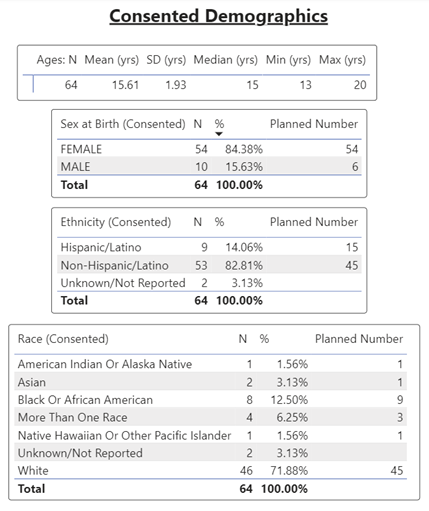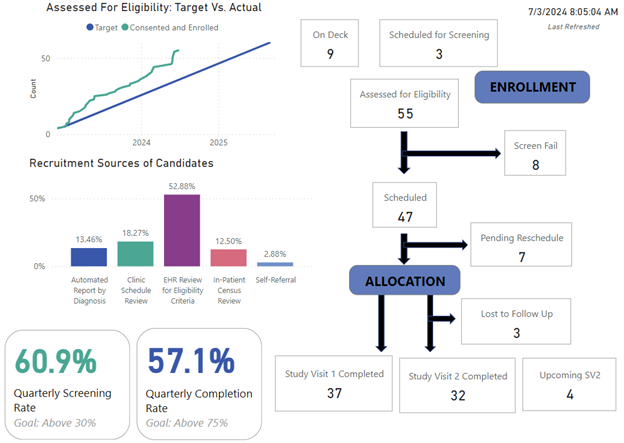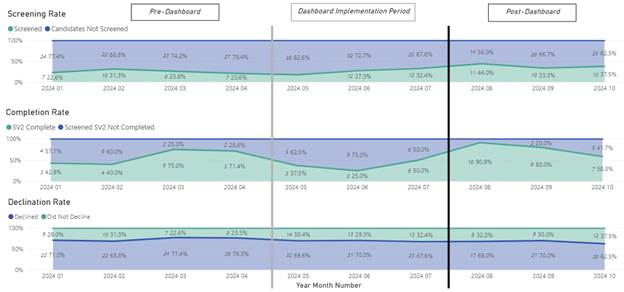Technology 3: Electronic Medical Records and Informatics
Session: Technology 3: Electronic Medical Records and Informatics
294 - Utilizing a Real Time Data Dashboard to Enhance Clinical Trial Recruitment Strategies in Academic Centers
Monday, April 28, 2025
7:00am - 9:15am HST
Publication Number: 294.7030
Anna E. Burns, Children's Mercy Hospitals and Clinics, Leawood, KS, United States; Mariah Brewe, Children's Mercy Hospitals and Clinics, Kansas City, MO, United States; John Tumberger, Children's Mercy Hospitals and Clinics, Kansas City, MO, United States; Michael Bartkoski, Children’s Mercy Kansas City, Kansas City, KS, United States; Stephani Stancil, Children's Mercy Hospitals and Clinics, Kansas City, MO, United States

Anna E. Burns, BS (she/her/hers)
Research Assistant
Children's Mercy Hospitals and Clinics
Leawood, Kansas, United States
Presenting Author(s)
Background: Recruitment challenges are a primary cause for clinical trial failure, impeding integration of actionable results into clinical care and ultimately inhibiting delivery of evidence-based care to patients. A data-informed approach can facilitate more effective recruitment. Proprietary software for monitoring recruitment is available, but barriers to implementation exist (e.g., high cost, duplicative data entry).
Objective: Development of a visual dashboard using widely available tools to enable efficient recruitment strategies for meeting clinical trial milestones in resource constrained settings.
Design/Methods: A real-time visual dashboard was developed to support a pediatric double-blind, cross-over randomized controlled clinical trial (NCT#05509257) using low or no-cost programs to facilitate interactive visualizations, detailed analysis and data quality control. Automated data retrieval occurred via a lab-developed R program utilizing REDCap API, the output integrated into Power BI (Microsoft, v2.130.930.0). Key metrics were calculated with custom Data Analysis Expression functions.
Results: Our visual dashboard allows for real-time, interactive monitoring of pediatric RCT (target n=60, ages 12-21 years, Fig 1). Key recruitment metrics (e.g., candidate source, target enrollment, declination rate, CONSORT flow metrics) are automatically updated daily (Fig. 2). Trends (e.g., screening rate, declination rate) are evaluated on rolling 90-day and static quarter bases. Additional visuals show participant’s progression from enrollment to study completion. Workflow optimization included resource allocation to most productive recruitment sources, adapted candidate call schedule, and data-informed timelines (e.g., average time from identifying potential candidate to completion of study). Cost of development was limited to a one-time research assistant effort (5% FTE). Upon full implementation of dashboard and workflow optimization, median days from candidate to study completion decreased from 78 to 74 days, screening and completion rates increased by 25.0% and 20.4%, respectively, compared to pre-implementation (Fig. 3).
Conclusion(s): A real-time visual dashboard optimized clinical trial recruitment by reducing length of study completion to meet milestones. Customizable metrics offer a comprehensive view of recruitment data and granularity to identify actionable issues through trial progression. This visual dashboard can be integrated into clinical trials to promote more timely completion by increasing data accessibility, using freely available resources to reduce budget constraints.
Figure 1
 Consented participant demographics, generated by Power BI.
Consented participant demographics, generated by Power BI.Figure 2
 Simulated Power BI dashboard summary of various recruitment metrics. Quarterly screening and completion rates can be color coded based on goal value
Simulated Power BI dashboard summary of various recruitment metrics. Quarterly screening and completion rates can be color coded based on goal valueFigure 3
 Power BI figures of rolling screening, completion, and declination rates, before implementation of visual dashboard (left of gray bar) and after 90 days (right of black bar). Note: figure has been abbreviated for clarity and starts in January 2024, while data collection began in October 2022.
Power BI figures of rolling screening, completion, and declination rates, before implementation of visual dashboard (left of gray bar) and after 90 days (right of black bar). Note: figure has been abbreviated for clarity and starts in January 2024, while data collection began in October 2022.Figure 1
 Consented participant demographics, generated by Power BI.
Consented participant demographics, generated by Power BI.Figure 2
 Simulated Power BI dashboard summary of various recruitment metrics. Quarterly screening and completion rates can be color coded based on goal value
Simulated Power BI dashboard summary of various recruitment metrics. Quarterly screening and completion rates can be color coded based on goal valueFigure 3
 Power BI figures of rolling screening, completion, and declination rates, before implementation of visual dashboard (left of gray bar) and after 90 days (right of black bar). Note: figure has been abbreviated for clarity and starts in January 2024, while data collection began in October 2022.
Power BI figures of rolling screening, completion, and declination rates, before implementation of visual dashboard (left of gray bar) and after 90 days (right of black bar). Note: figure has been abbreviated for clarity and starts in January 2024, while data collection began in October 2022.
